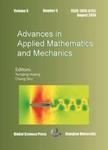An Algebraic Multigrid Method for Nearly Incompressible Elasticity Problems in Two-Dimensions
作者机构:Civil Engineering and Mechanics CollegeXiangtan UniversityXiangtan 411105People’s Republic of China School of Mathematics and Computational ScienceXiangtan UniversityXiangtan 411105People’s Republic of China Department of Mathematics and PhysicsHunan University of TechnologyZhuzhou 412008People’s Republic of China
出 版 物:《Advances in Applied Mathematics and Mechanics》 (应用数学与力学进展(英文))
年 卷 期:2009年第1卷第1期
页 面:69-88页
核心收录:
学科分类:08[工学] 082304[工学-载运工具运用工程] 080204[工学-车辆工程] 0802[工学-机械工程] 0701[理学-数学] 0801[工学-力学(可授工学、理学学位)] 0823[工学-交通运输工程]
基 金:supported in part by NSF-10771178 and NSF-10672138 in China the Basic Research Program of China under the grant 2005CB321702 the Key Project of Chinese Ministry of Education and the Scientific Research Fund of Hunan Provincial Education Department(208093,07A068) the Provincial Natural Science Foundation of Hunan(07JJ6004)
主 题:Locking phenomenon algebraic multigrid higher-order finite element two-level method reduced integration
摘 要:In this paper,we discuss an algebraic multigrid(AMG)method for nearly incompressible elasticity problems in ***,a two-level method is proposed by analyzing the relationship between the linear finite element space and the quartic finite element *** choosing different smoothers,we obtain two types of two-level methods,namely TL-GS and *** theoretical analysis and numerical results show that the convergence rates of TL-GS and TL-BGS are independent of the mesh size and the Young’s modulus,and the convergence of the latter is greatly improved on the order *** the convergence of both methods still depends on the Poisson’s *** fix this,we obtain a coarse level matrix with less rigidity based on selective reduced integration(SRI)method and get some types of two-level methods by combining different *** the existing AMG method used as a solver on the first coarse level,an AMG method can be finally *** results show that the resulting AMG method has better efficiency for nearly incompressible elasticity problems.



